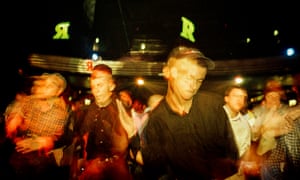170 words per minute: rediscover drum’n’bass novel Junglist
Andrew Green and Eddie Otchere were teenage ravers who turned early-90s jungle into mutant modernism prose. In his foreword to a reissued edition, Sukhdev Sandhu explains its power, alongside photos from the era by Otchere

Andrew Green and Eddie Otchere – AKA Two Fingas and James T Kirk, whose extraordinary collaborative novel Junglist is reissued this month – came of age at a strange, indeterminate time. It was the early 1990s, post-Thatcher and post-Berlin Wall: a period of fudge and inertia, of recession and housing market collapse, of Britain being forced to leave the European Exchange Rate Mechanism. The Greater London Council had been abolished in 1986 and the city still had no mayor. Tourists were in short supply; bombs – the IRA attacked the Baltic Exchange, Bishopsgate, even Downing Street – were not.
Green and Otchere were from council estates south of the Thames in Vauxhall. The MI5 building had yet to go up in the neighbourhood and it was hard to imagine that the US embassy would one day move there. Where they lived, squatters were common. The fires that often broke out would have caused even more devastation than they did if the high-rise walling wasn’t so stuffed with asbestos. Turning 16, the two teenagers, both creative and independently minded, headed across town to Hammersmith and West London College. There they bonded over a shared love of comics, basketball, kung fu movies. Music, too.
Green had been a hip-hop and happy hardcore fan. Increasingly he was getting into jungle. He viewed the club nights he attended as extensions of the house parties of his youth: front rooms cleared of all furniture, huge sound systems, alcohol served in plastic cups, dim lighting, lots of motion. He found jungle intimate and immersive – a sometimes demonised music to which young kids, in darkened spaces the size of chill-out zones, were still figuring out how to dance. It was a music that was impossibly accelerationist. Its rhythms thrillingly alien. Its darkness radiant.
Otchere, a photographer with a keen eye for social semiotics, had noticed that “the white racist kids that I went to school with came back from their summer holidays not racist any more. I was trying to figure out what the fuck happened.” Jungle offered a partial answer:
The rave culture we as Black kids in south London started to experience in the 90s began four years earlier with those white kids. We saw how much fun they were having and brought it into our own circles. By just dancing together, by mimicking each other’s body movements, by being under the same roof, listening to the same music, feeling the same high, taking the same pills: in that magic moment the moodiness was gone.
Jungle had its own subaltern economy. White-label 12-inch records were produced on the cheap, pressed up by tiny independents, spun at clubs and by pirates, sometimes sold from the boots of cars. Cash in hand. Not a word to the taxman. DIY creativity at its most kinetic and entrepreneurial.
Some of that energy was channelled into publishing. Deadmeat, a novel about a Black cyber-vigilante stalking the streets of London, was initially sold at clubs by its author “Q”. Better known is The X-Press, an imprint set up by Dotun Adebayo and Steve Pope in 1992, which published Victor Headley’s Yardie and Donald Gorgon’s Cop Killer. These books were often accused of glorifying violence and of being no-brow trash, but their hefty sales were hard to ignore.
One individual paying particular attention was Jake Lingwood, a twentysomething editor at Boxtree. He had a passion for mod and, as a teenager, had started the zine Smarter Than U!, which he named after a song on the Undertones’ 1978 Teenage Kicks EP. Excited by the energy of the London club scene, he decided to commission a series of novel-length documentations that would allow outsiders to peek into social worlds they might otherwise have felt too intimidated to actually visit or join. He named it Backstreets, and was soon casting about for writers prepared to bash out vaguely workable prose in a couple of months and for an advance of a few thousand pounds.
By this time, Green and Otchere had figured out, as canny youngsters tend to, that the best way to get free records and tickets – swag – was by writing for magazines. They were penning film reviews for Black lifestyle journal Touch; Otchere was also taking photos for it and had contributed cover images for X-Press titles. He’d even shot something for one of the first Backstreets novels. If in retrospect it seems obvious that Lingwood would ask him to write a drum’n’bass-themed volume – and that he would ring his friend to suggest they collaborate on it – initially there were some tricky issues to resolve.
Neither of them were particularly interested in literary fiction (“a term I despise,” says Green today); the word-length was 50,000 (about 48,000 longer than anything either of them had ever written before); Green was now up country studying film at Northumbria University. Otchere says he’d never even read a full-length novel up to that point, preferring instead the wordplay and poetry of the sleeve notes on Sun Ra LPs.
Still, they said yes. Green remembers thinking, “Fuck it, why not? I was 18 or 19 – full of young person confidence.” He had felt “a weird sense of dislocation” in Newcastle; writing about London was a chance to take stock of his upbringing and the music that had rewired him. The book would be a quota-quickie – like youthsploitation novels such as Wolf Mankowitz’s Expresso Bongo (1958) and Richard Allen’s Skinhead (1970, a key reference point for Lingwood), but also like those pulp fictions historically churned out by the comic and sci-fi writers Green adored. He could stay anonymous – like a graffer or an underground producer issuing multiple releases under different pseudonyms. He and Otchere could even use the excuse of writing it as a way to get on guest lists and jump the queues at otherwise rammed clubs. Research!
Green and Otchere decided on a simple narrative arc: a long weekend, Friday through to Monday morning, in the lives of four south Londoners – Meth, Q, Biggie and Craig – who they based on themselves and their mates. It’s often hard to tell them apart, their voices and personalities melting into a polyphonic mix, a scattershot and bantz-heavy flow of the kind that might be heard on a pirate station. They have minor run-ins with the police as they drive across town in Q’s mum’s Cortina, but this isn’t a protest or a journalistic novel; it’s more interested in inner space than in sociological space, the psychology of urban life as it’s modulated by beats and weed.
Otchere, in particular, liked to hammer out his chapters at 4am after returning home from bunning it at clubs. Junglist’s prose vibrates as much as it documents. It’s been happily contaminated by the music it loves, treating rhythm as a virus it in turn can transmit to the reader. Mutant modernism is the stylistic default. It begins with an epigraph – “Jungle is a headfuck. The sound of a transformer banging its head against a wall.” It ends with a glossolalic A-Z that resembles a lysergic take on Molly Bloom’s epic stream of consciousness in Ulysses: “rumblism, rupert, sade, scamming, schott, schwarzenigga, secs, sega, semesterisation …”
Junglist isn’t polished or smooth. It’s, well, junglist rather than drum’n’bassist. A recurring motif is the middle-class “false consciousness” of house music. The prose jabs and concusses, bristles with millennial tension, is galvanised by the “guerilla dance, guerilla musicality” of the scene. There’s also a lot of humour – Boy’s Own knob gags, a chapter in which Craig has strife with the Jehovah’s Witnesses at his Sunday morning front door. A scene in which Meth ruffles Q’s semi-afro while smiling a goofy smile at him is as tear-inducingly tender as anything to be found in more vaunted Black British fictions.
Most startling is how surreally Green and Otchere chafe against the reportage remit of the Backstreets series and push towards abstraction, evoking nocturnal London in terms of heat and colour, gravity and anti-gravity. One chapter is entitled Craig’s Obsession: Twelve Inches of Plastic in a Quasi-Rotational Plane of Existence and a Parrot. Another begins: “Towards the sky I flew in a surge of tranquillity and found the unlimited existence in the shape of ultramarine.” This is Vauxhall kosmische, prole-art Swedenborgianism, tower-block psychedelia, the dissident spiritualism of William Blake and Thomas De Quincey transmigrating into the rhythmic matrix of Leviticus’s Burial and Deep Blue’s The Helicopter Tune.
Junglist was written before White Teeth, before Brick Lane, before literary publishers made a concerted push to foreground “minority” voices. It predates the rise of psychogeography, whose studied melancholia it has little interest in. It captures jungle in the intense now, as a way of being – not merely as a musical subculture, or as an edgy scene to be snapped, tagged and circulated on social media. Much of its first run had to be pulped after MC 5ive-0 threatened to sue because he’d not given permission for a photo of him to appear on the front cover. It didn’t sell a lot and got scant reviews. The Backstreets series itself fizzled out. At one point, Junglist was reputed to be the most stolen book in the London prison system.
Green went on to work in television, Otchere focused on photography. For decades neither of them picked up or reread the novel. Now, in decelerated, socially distanced times, there’s a palpable nostalgia for the music and momentum of the rave era, its innovations and future shock, its ability to make mayhem and magic in downturn Britain. Junglist – timeshifting, between genres, tonally wrong-stepping – may finally have found its moment. It’s such an avant-pulp anomaly, though, that I wouldn’t bet on it.
This essay is printed in the new edition of Junglist, out now and published by Repeater Books.



